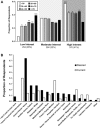Cannabis use among patients at a comprehensive cancer center in a state with legalized medicinal and recreational use
- PMID: 28944449
- PMCID: PMC5698756
- DOI: 10.1002/cncr.30879
Cannabis use among patients at a comprehensive cancer center in a state with legalized medicinal and recreational use
Abstract
Background: Cannabis is purported to alleviate symptoms related to cancer treatment, although the patterns of use among cancer patients are not well known. This study was designed to determine the prevalence and methods of use among cancer patients, the perceived benefits, and the sources of information in a state with legalized cannabis.
Methods: A cross-sectional, anonymous survey of adult cancer patients was performed at a National Cancer Institute-designated cancer center in Washington State. Random urine samples for tetrahydrocannabinol provided survey validation.
Results: Nine hundred twenty-six of 2737 eligible patients (34%) completed the survey, and the median age was 58 years (interquartile range [IQR], 46-66 years). Most had a strong interest in learning about cannabis during treatment (6 on a 1-10 scale; IQR, 3-10) and wanted information from cancer providers (677 of 911 [74%]). Previous use was common (607 of 926 [66%]); 24% (222 of 926) used cannabis in the last year, and 21% (192 of 926) used cannabis in the last month. Random urine samples found similar percentages of users who reported weekly use (27 of 193 [14%] vs 164 of 926 [18%]). Active users inhaled (153 of 220 [70%]) or consumed edibles (154 of 220 [70%]); 89 (40%) used both modalities. Cannabis was used primarily for physical (165 of 219 [75%]) and neuropsychiatric symptoms (139 of 219 [63%]). Legalization significantly increased the likelihood of use in more than half of the respondents.
Conclusions: This study of cancer patients in a state with legalized cannabis found high rates of active use across broad subgroups, and legalization was reported to be important in patients' decision to use. Cancer patients desire but are not receiving information about cannabis use during their treatment from oncology providers. Cancer 2017;123:4488-97. © 2017 The Authors. Cancer published by Wiley Periodicals, Inc. on behalf of American Cancer Society. This is an open access article under the terms of the Creative Commons Attribution-NonCommercial-NoDerivs License, which permits use and distribution in any medium, provided the original work is properly cited, the use is non-commercial and no modifications or adaptations are made.
Keywords: cancer; cannabis; marijuana; pain; supportive care.
© 2017 The Authors. Cancer published by Wiley Periodicals, Inc. on behalf of American Cancer Society.
Figures




Comment in
-
The pot dealer state harms patients with cancer.Cancer. 2018 May 15;124(10):2255-2256. doi: 10.1002/cncr.31358. Epub 2018 Mar 30. Cancer. 2018. PMID: 29603184 No abstract available.
-
Reply to The pot dealer state harms patients with cancer.Cancer. 2018 May 15;124(10):2256-2257. doi: 10.1002/cncr.31360. Epub 2018 Mar 30. Cancer. 2018. PMID: 29603196 No abstract available.
References
-
- Center for Behavioral Health Statistics and Quality . Key substance use and mental health indicators in the United States: results from the 2015 National Survey on Drug Use and Health. http://www.samhsa.gov/data/sites/default/files/NSDUH‐FFR1‐2015/NSDUH‐FFR... Accessed February, 2016.
-
- Azofeifa A, Mattson M, Schauer G, McAfee T, Grant A, Lyerla R. National estimates of marijuana use and related indicators—National Survey on Drug Use and Health, United States, 2002‐2014. MMWR Surveill Summ. 2016;65:1‐28. - PubMed
-
- Abrams DI, Guzman M. Cannabis in cancer care. Clin Pharmacol Ther. 2015;97:575‐586. - PubMed
MeSH terms
Substances
Grants and funding
LinkOut - more resources
Full Text Sources
Other Literature Sources
Medical

